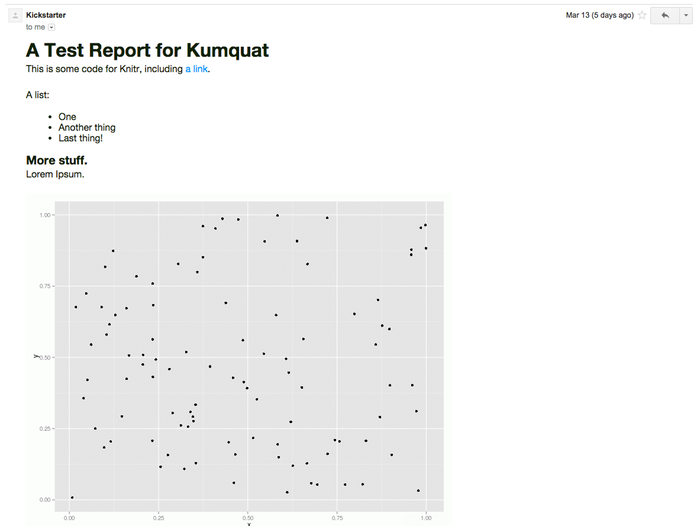

Behold.” This is when someone only pushes their source, i.e. Here are two behaviors I find very frustrating: However, certain practices make this effort at publishing more satisfying for your audience. No matter what, technically you can publish this report merely by pushing a rendered version to GitHub. If you’ve been making HTML, you can put that up on the web somewhere, email it to your collaborator, whatever. Your YAML should now look more like this: Select “Output options” and go to the Advanced tab and check “Keep markdown source file.” You can make some YAML changes via the RStudio IDE: click on the “gear” in the top bar of the source editor, near the “Knit HTML” button. Rmd documents, i.e. the text at the top of your file between leading and trailing lines of. Output format is one of the many things we can control in the YAML frontmatter of.

md files is why so many R packages have a NEWS.md file and README.md, often generated from README.Rmd. This point we’re making about the importance of. If you still want the HTML but also the intermediate markdown, there’s a way to request that too. Where foo.md is GitHub-flavored markdown. This means rendering look like this: foo.Rmd -> foo.md In that case, we switch the output format to github_document. In many cases, you only want the markdown. In contrast, HTML is rendered as plain text on GitHub and you’ll have to take special measures to see it the way you want.
#Rmarkdown github readme for free#
This is great because it preserves all the charms of plain text, but gives you a pseudo-webpage for free when you visit the file in the browser. They are rendered in an almost HTML-like way. GitHub gives very special treatment to markdown files. The magical process that turns your R Markdown to HTML is like so: foo.Rmd -> foo.md -> foo.htmlīy default RStudio discards this, but you might want to hold on to that markdown file! This is another good time to commit changes. foo.Rmd AND the resulting HTML foo.html.Ĭongratulations, you’ve just made your first reproducible report with R Markdown. You should see the original R Markdown document, i.e. RStudio should display a preview of the resulting HTML. Making change very visible is one of the big benefits of using Git.Ĭlick on “Knit HTML” or do File > Knit Document. That will help you see exactly what’s happening with your files, because this will appear as a “diff” in the Git pane. Trust me on this and do this for a while. Save in the top-level of this RStudio project and Git repository, that is also current working directory.

Save this document to a reasonable filename and location. Accept the default output format of HTML.Accept the default Author or edit if you wish.The filename is for humansĪnd computers, so it should have similar words in it but no spaces and no But the title andįilename should be related! Why confuse yourself? The title is for humanĮyeballs, so it can contain spaces and punctuation. Necessarily have anything to do with the file’s name. This will appear in the document but does not We test our system’s ability to render the “hello world” of R Markdown documents before we muddy the waters with our own, probably buggy, documents. It is best to increase complexity in small increments. We are modelling “walk before you run” here. Launch RStudio in a Project that is a Git repo that is connected to a GitHub repo. This will update, and now you can also see your project website with a default index.We’ll practice with RStudio’s boilerplate R Markdown document. Then Push (up green arrow) to push the locally committed changes on your lapto up to the Github repository online.
#Rmarkdown github readme code#
Notice how the code plot(pressure) is not shown in the HTML output because of the R code chunk option echo=FALSE.īefore we continue exploring Rmarkdown, visit the Git pane, check all modified (M) or untracked (?) files, click Commit, enter a message like “added index” and click the “Commit” button. These are evaluated and return the output text in the case of summary(cars) and the output plot in the case of plot(pressure). Notice how the markdown is rendered similar to as before + R code chunks are surrounded by 3 backticks and. Some initial text is already provided for you. After you click OK, most importantly File -> Save as index (which will get named with the filename extension index.Rmd). Back in RStudio, let’s create a new Rmarkdown file, which allows us to weave markdown text with chunks of R code to be evaluated and output content like tables and plots.įile -> New File -> Rmarkdown… -> Document of output format HTML, OK.


 0 kommentar(er)
0 kommentar(er)
